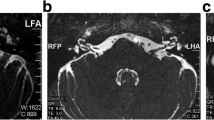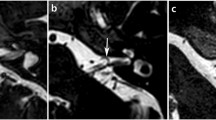Abstract
The purpose was to investigate patients with unexplained pulsatile and non-pulsatile tinnitus by means of MR imaging of the cerebellopontine angle (CPA) and to correlate the clinical subtype of tinnitus with the location of a blood vessel (in the internal auditory canal or at the cisternal part of the VIIIth cranial nerve). Clinical presentation of tinnitus and perceptive hearing loss were correlated. In 47 patients with unexplained tinnitus, an MR examination of the CPA was performed. Virtual endoscopy reconstructions were obtained using a 3D axial thin-section high-resolution heavily T2-weighted gradient echo constructive interference in steady state (CISS) data-set. High-resolution T2-weighted CISS images showed a significantly higher number of vascular loops in the internal auditory canal in patients with arterial pulsatile tinnitus compared to patients with non-pulsatile tinnitus (P<0.00001). Virtual endoscopy images were used to investigate vascular contacts at the cisternal part of the VIIIth cranial nerve in patients with low pitch and high pitch non-pulsatile tinnitus. A significantly different distribution of the vascular contacts (P=0.0320) was found. Furthermore, a correlation between the clinical presentation of non-pulsatile tinnitus (high pitch and low pitch) and the perceptive hearing loss was found (P=0.0235). High-resolution heavily T2-weighted CISS images and virtual endoscopy of the CPA can be used to evaluate whether a vascular contact is present in the internal auditory canal or at the cisternal part of the VIIIth cranial nerve and whether the location of the vascular contact correlates with the clinical subtype of tinnitus. Our findings suggest that there is a tonotopical structure of the cisternal part of the VIIIth cranial nerve. A correlation between the clinical presentation of tinnitus and hearing loss was found.








Similar content being viewed by others
References
Lockwood AH, Salvi RJ, Burkard RF (2002) Tinnitus. N Engl J Med 347:904–910
Roy D, Chopra R (2002) Tinnitus: an update. J R Soc Health 122:21–23
Nondahl DM, Cruickshanks KJ, Wiley TL, Klein R, Klein BE, Tweed TS (2002) Prevalence and 5-year incidence of tinnitus among older adults: the epidemiology of hearing loss study. J Am Acad Audiol 13:323–331
Marsot-Dupuch K (2001) Pulsatile and nonpulsatile tinnitus: a systemic approach. Semin Ultrasound CT MR 22:250–270
Weissman JL, Hirsch BE (2000) Imaging of tinnitus: a review. Radiology 216:342–349
Moller AR (1991) The cranial nerve vascular compression syndrome. I. A review of treatment. Acta Neurochir (Wien) 113:18–23
Parnes LS, Shimotakahara SG, Pelz D, Lee D, Fox AJ (1990) Vascular relationships of the vestibulocochlear nerve on magnetic resonance imaging. Am J Otolaryngol 11:278–281
Vasama JP, Moller MB, Moller AR (1998) Microvascular decompression of the cochlear nerve in patients with severe tinnitus. Preoperative findings and operative outcome in 22 patients. Neurol Res 20:242–248
Brookes GB (1996) Vascular decompression surgery for severe tinnitus. Am J Otolaryngol 17:569–576
Ryu H, Tanaka T, Yamamoto S, Uemura K, Takehara Y, Isoda H (1999) Magnetic resonance cisternography used to determine precise topography of the facial nerve and three components of the eighth cranial nerve in the internal auditory canal and cerebellopontine cistern. J Neurosurg 90:624–634
Casselman JW, Kuhweide R, Deimling M, Ampe W, Dehaene I, Meeus L (1993) Constructive interference in steady state-3DFT MR imaging of the inner ear and cerebellopontine angle. Am J Neuroradiol 14:47–57
McDermott AL, Dutt SN, Irving RM, Pahor AL, Chavda SV (2003) Anterior inferior cerebellar artery syndrome: fact or fiction. Clin Otolaryngol 28:75–80
Nowé V, Michiels JLP, Salgado R, De Ridder D, Van de Heyning PH, De Schepper AM, Parizel PM (2004) High-resolution virtual MR endoscopy of the cerebellopontine angle. Am J Roentgenol 182:379–384
Akimoto H, Nagaoka T, Nariai T, Takada Y, Ohno K, Yoshino N (2002) Preoperative evaluation of neurovascular compression in patients with trigeminal neuralgia by use of three-dimensional reconstruction from two types of high-resolution magnetic resonance imaging. Neurosurgery 51:956–962
Meikle MB, Vernon J, Johnson RM (1984) The perceived severity of tinnitus. Some observations concerning a large population of tinnitus clinic patients. Otolaryngol Head Neck Surg 92:689–696
Norena A, Micheyl C, Chery-Croze S, Collet L (2002) Psychoacoustic characterization of the tinnitus spectrum: implications for the underlying mechanisms of tinnitus. Audiol Neurootol 7:358–369
Ochi K, Ohashi T, Kenmochi M (2003) Hearing impairment and tinnitus pitch in patients with unilateral tinnitus: comparison of sudden hearing loss and chronic tinnitus. Laryngoscope 113:427–431
Moller AR (1999) Vascular compression of cranial nerves. II. Pathophysiology. Neurol Res 21:439–443
Makins AE, Nikolopoulos TP, Ludman C, O’Donoghue GM (1998) Is there a correlation between vascular loops and unilateral auditory symptoms? Laryngoscope 108:1739–1742
Brandt T, Dieterich M (1994) VIII nerve vascular compression syndrome: vestibular paroxysmia. Baillieres Clin Neurol 3:565–575
Jannetta PJ (1979) Microsurgery of cranial cross-compression. Clin Neurosurg 26:607–615
De Ridder D, Moller A, Verlooy J, Cornelissen M, De Ridder L (2002) Is the root entry/exit zone important in microvascular compression syndromes? Neurosurgery 51:427–434
Tarlov IM (1937) Structure of the nerve root. Part 1. Nature of the junction between the central and the peripheral nervous system. Arch Neurol Psychiatry 37:555–583
Lang J (1982) Anatomy, length and blood vessel relations of “central” and “peripheral” paths of intracisternal cranial nerves. Zentralbl Neurochir 43:217–258
Schwaber MK, Garraghty PE, Kaas JH (1993) Neuroplasticity of the adult primate auditory cortex following cochlear hearing loss. Am J Otolaryngol 14:252–258
Pantev C, Lutkenhoner B (2000) Magnetoencephalographic studies of functional organization plasticity of the human auditory cortex. J Clin Neurophysiol 17:130–142
Wessinger CM, Buonocore MH, Kussmaul CL, Mangun GR (1997) Tonotopy in human auditory cortex examined with functional magnetic resonance imaging. Hum Brain Mapp 5:18–25
Kaltenbach JA, Meleca RJ, Falzarano PR (1996) Alterations in the tonotopic map of the cochlear nucleus following cochlear damage. In: Salvi RJ, Henderson D, Fiorino F, Colletti V (eds) Auditory system plasticity and regeneration. Thieme Medical, New York, pp 317–332
Arnesen AR, Osen KK (1978) The cochlear nerve in the cat: tonography, cochleotopy, and fiber spectrum. J Comp Neurol 178:661–678
Spoendlin H, Schrott A (1989) Analysis of the human auditory nerve. Hear Res 43:25–38
Felix H, Johnsson LG, Gleeson MJ, de Fraissinette A, Conen V (1992) Morphometric analysis of the cochlear nerve in man. Acta Otolaryngol 112:284–287
Author information
Authors and Affiliations
Corresponding author
Rights and permissions
About this article
Cite this article
Nowé, V., De Ridder, D., Van de Heyning, P.H. et al. Does the location of a vascular loop in the cerebellopontine angle explain pulsatile and non-pulsatile tinnitus?. Eur Radiol 14, 2282–2289 (2004). https://doi.org/10.1007/s00330-004-2450-x
Received:
Revised:
Accepted:
Published:
Issue Date:
DOI: https://doi.org/10.1007/s00330-004-2450-x




